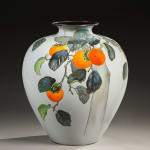WORKS FOR SALE
A CLOISONNÉ ENAMEL VASE BY ANDO JUBEI (1876–1956)
Provenance
Sold Sotheby’s, London, 11 March 1982
Distinguished Private Collection: London, UK
Literature
COMPARE:
For a similar vase by Ando Jubei, see Oliver Impey and Malcolm Fairley, eds., The Nasser D. Khalili Collection of Japanese Art, vol. III Meiji no Takara, Treasure of Imperial Japan: Enamel (London, The Kibo Foundation, 1995), pl. 55
Publications
Art at Auction: The Year at Sotheby’s, 1981-82, p. 270
Gregory Irvine, Japanese Cloisonné Enamels: The Seven Treasures (London, V&A Museum, 2006), p. 124
A Cloisonne Enamel Vase by Ando Jubei.
Japanese, Meiji era (1868-1912), early 20th century
The large, rounded body features fine silver wirework and vivid enamels depicting a persimmon tree with orange fruit on a pale blue background. Surmounted with and silver rim and foot.
The Ando Jubei Company
The Ando Cloisonné Company (安藤七宝店, Andō Shippōten), founded in Nagoya in the late 19th century, became synonymous with the highest achievements in Japanese cloisonné enamelling. Its founder, Ando Jubei (1876–1953), was one of the most celebrated enamel artists of the Meiji era, and the company he established quickly became one of Japan’s most successful and internationally recognised enamel workshops.
Trained in the techniques of cloisonné (shippō) from a young age, Ando Jubei rose to prominence through a combination of technical innovation, artistic ambition, and strategic international presentation. His company was one of only a few granted the right to produce works for the Imperial Household, and it regularly exhibited at world fairs and international expositions from the 1890s onward, including the World’s Columbian Exposition in Chicago (1893), the Paris Exposition Universelle (1900), and others.
Technical Mastery and Innovation
Ando Jubei’s success lay not only in faithful execution of traditional cloisonné techniques but in his workshop’s innovation and refinement of the medium. The company was instrumental in perfecting techniques such as:
• Moriage-jippo (盛上七宝): A raised enamel technique, as seen on the current vase, where areas of design are built up in high relief to mimic three-dimensional modelling.
• Musen-jippo (無線七宝): “Wireless” cloisonné, developed in conjunction with Namikawa Sōsuke, in which silver wires are removed before firing to allow more painterly effects.
• Yūsen-jippo (有線七宝): Traditional wire cloisonné, where compartments are created with silver or gold wire before enamel is inlaid.
The combination of raised moriage technique with delicate silver wire outlines, as used on this vase, demonstrates a mature synthesis of decorative and technical refinement. The naturalistic treatment of the persimmon tree, with attention to the gradation of colour and the shading of leaves, speaks to the increasing influence of Nihonga painting on decorative arts in the early 20th century.
Reputation and Legacy
Ando Jubei’s works are held in major museum collections worldwide, including the Victoria and Albert Museum, the Tokyo National Museum, and the Museum of Fine Arts, Boston. His company became the leading cloisonné workshop after the decline of the Tokyo-based Namikawa Yasuyuki and Namikawa Sōsuke ateliers, and it remains in operation today.
The Ando firm was also a critical conduit for introducing Japanese cloisonné to Western collectors, producing exquisite presentation pieces for export as well as for use by Japanese nobility.



